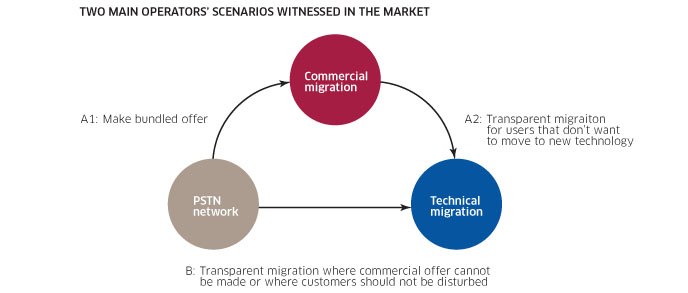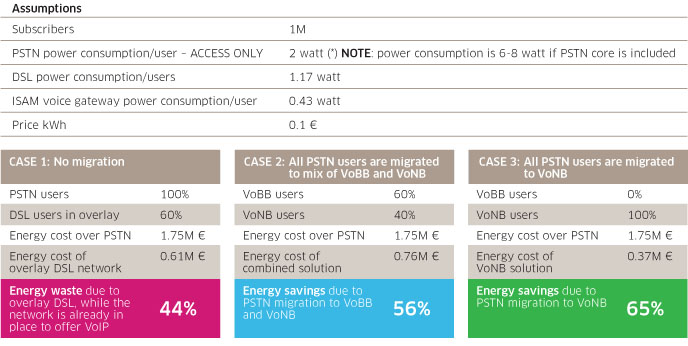Ana Pesovic, Luis Alberto Martin Santiago, Alcatel-Lucent
Service providers have realized that the public switched telephone network (PSTN) needs to be transformed, but there are still many controversies about how to handle the transition and what kind of solutions are deployed. At present, most of the investment is focused on upgrading the network to ultra-high-speed broadband. These broadband upgrades will eventually promote PSTN transformation. With the right combination of mobile, fixed broadband and narrowband technologies, service providers can migrate PSTNs to IP-based networks, saving costs and opening up new revenue opportunities.
Why the PSTN needs to be remodeled
For decades, the PSTN has been a reliable source of revenue for voice services. So, why should service providers consider replacing the proven TDM-based technology with IP-based voice services? There are three good reasons to explain why the PSTN transformation is a very worthwhile option.
First, TDM-based speech technology is approaching the final moments of its life cycle. Most equipment suppliers have announced the end of the life cycle of PSTN products and maintenance contracts in 2018. Service providers will find it increasingly difficult to upgrade and maintain their traditional PSTN devices. They must find other feasible solutions to fill this gap.
Second, PSTN revenue is declining. Today, TDM-based voice services can no longer bring new revenue. More and more service providers are replacing analog voice services with packet-based digital voice services, enabling them to provide new services, generate new revenues, and prevent customers from escaping.
Third, PSTN operation and maintenance costs continue to rise. As more users move to mobile and digital voice services, fewer users are still using their service provider's TDM network. However, PSTN equipment and switching office rooms still exist and must be maintained. In addition to maintenance costs and the cost of the equipment room, a single user cost is further increased due to various factors such as low port utilization, increasing hardware failures, aging equipment, soaring energy costs, and tougher environmental regulations.
Why investing in PSTN makes sense
Service providers typically operate several networks at the same time—for example, there is a TDM network for voice services and an IP network for data services. For many service providers, an ideal solution is to consolidate all network operations and services on a single IP-based network.
An IP-based unified network provides some major advantages. For example, it can evolve, debug, and operate more efficiently than operating a TDM network or operating multiple parallel networks. It can increase revenue by providing attractive new services. More importantly, it is future-oriented, so it can easily evolve step-by-step as technology and user needs change.
Every service provider wants to enjoy these benefits. But the reality is that it is not easy to migrate all PSTN capabilities from TDM to IP networks. As the migration advances, service providers will face some complex business operational challenges. Before deciding to make a PSTN transformation, service providers must think about the role of the PSTN in the coming years and how it can be used to make it work.
For a PSTN transformation implementation case, there are some key factors that must be considered:
Customer churn: Users will use mobile and broadband voice services more. The number of PSTN subscribers in different regions has decreased year by year: 10% in North America, 6% in Europe, Middle East and Africa, 3% in Asia Pacific, and less than 1% in the Caribbean and Latin America. By 2023, 60% of U.S. households will only use wireless voice services, and 20% of U.S. households will only use VoIP services. Increasing popularity of broadband: Broadband construction is spread all over the world. Service providers need to find ways to use these broadband deployments to upgrade their voice services. The need for smooth migration: Many users want to maintain existing voice services. Forced migration may create opportunities for competitors and result in loss of customers. Operators must ensure that these customers avoid interference during the migration process to prevent customers from escaping.Due to the reduced demand for PSTN voice services, there are reasons to question the investment in PSTN networks. The fact is that PSTN services are not disappearing soon. Although a large majority of users will eventually migrate to digital or wireless voice, many still continue to rely on plain old telephone service (POTS). Even in a highly developed market, there are always users who do not want to upgrade or cannot upgrade. For example, a recent evaluation showed that 20% of U.S. households will still use POTS-based voice services in 2023. Investing in PSTN replacement is reasonable because it can reduce costs for voice services that generate revenue, and it can easily introduce a new generation of IP-based services, including portals and smartphone clients.
Build a migration strategy around end users
Service providers can use commercial and technical migration tools to migrate PSTN users to IP networks.
In commercial migration approaches, service providers migrate voice customers as part of new service contracts to new networks, such as bundled services, including Internet access, broadband voice, or IPTV. This strategy carries certain risks because not all customers are willing to sign new service contracts. When a new contract price is proposed, some people may take this opportunity to turn to competitors or to completely withdraw all existing services.
Technology migration is completely transparent to users. Users can continue to use the same service contract and business. The risk of user churn for technology migration is minimal because there is no change in service and no additional customer interaction during the period.
In the PSTN relocation process, service providers should first consider providing business migration through bundled services. Second, they can provide technology migration for users who are reluctant or unable to migrate.

Figure 1 Business or Technology Migration? Building a User-Centered PSTN Migration Strategy
Choose the right combination of technologies
There is no single "best" technology for PSTN migration. Service providers need a combination that can balance customer needs and preferences and provide cost-effective migration technologies. The key is to consider what the customer needs. For example, a user who has used the same voice technology for many years may be concerned about changes to the original business experience. Other users may be excited about the opportunity to migrate to new technologies because they can take advantage of the latest technologies. Merging different migration technologies will help ensure user satisfaction.
What kind of technology can be part of the PSTN migration? Here are a few clear candidate technologies:
Broadband voice will enable service providers to take full advantage of the global growth in broadband deployments to provide PSTN services over copper cables or access lines. In the absence of broadband or interference with the customer, narrowband voice will be a suitable choice. Mobile voice will be a supplement, but it is still the first choice in some cases, especially for young consumers who have grown up in a fixed-line environment.
Wideband voice or narrowband voice
The main difference between wideband voice and narrowband voice is the location of the voice gateway function - in other words, the endpoint of the Session Initiation Protocol (SIP) and the location of the analog-to-digital conversion point. For wideband voice, the function of the voice gateway is on the end-user side, such as an IAD, DSL modem, or Optical Network Terminal (ONT). This conversion was previously implemented in the network. For narrowband voice, the voice gateway function is located at the access point and the switch occurs at the switch in the network.
Both narrowband voice and wideband voice can provide near-perfect support for all legacy services' simulated PSTN services. If the user can continue to use the existing analog phone, the migration is transparent to the end user. Broadband voice also has the ability to emulate the most commonly used PSTN services. Simulation services may have different experiences in specific situations, but they also provide service providers with opportunities for IP telephony users to provide new services such as Push-to-talk and IP Centrex.
The advantages of narrowband voice
In all cases, a combination of multiple migration technologies is required. However, narrowband voice does provide some special attention to service providers. These advantages include:
No impact on end users: Narrowband voice provides completely transparent migration. Service providers can maintain service continuity without going to the door, calling or otherwise making additional appointments with users. There is no additional capital expenditure on the end user side: For narrowband voice, since the device is in the network, there is no need to install new devices on the user side. Broadband Gateways: In areas where broadband deployment is relatively backward, narrowband voice migration is beneficial to service providers' future broadband deployment. Low cost of operation and maintenance: The maintenance of narrowband voice is convenient. All POTS ports are on the network, and there is no IP phone on the end-user side that needs to provide support. In addition, the technology has a small footprint and low power consumption in the engine room.
Benefits of PSTN Transformation
The transition to IP technology offers some important advantages compared to TDM-based PSTN networks. For example, moving to digital voice can help service providers reduce room costs. With more compact equipment for IP networks, operators can focus on integrating or eliminating inefficient or outdated switching rooms, which can also significantly reduce energy costs.
In fact, the PSTN migration provides a double benefit in terms of energy savings. First, energy waste is avoided by avoiding the operation of multiple parallel networks. Second, broadband speech and narrow-band speech consume 6-8 times less power than the PSTN, which provides excellent energy-saving opportunities. Figure 2 shows the PSTN user's migration to voice services combined with broadband and narrowband technologies to enable service providers to achieve energy cost savings. If all PSTN users migrate to narrowband voice, energy savings will be even more pronounced.

Figure 2 PSTN Migration Provides Significant Reduction in Energy Costs
PSTN migration can also provide a way to increase revenue. With wideband voice, service providers can increase ARPU by providing new services and features, such as second phones, soft phones, service management portals, voice mail, and email combinations. In areas where broadband is not widely deployed, service providers can provide narrowband voice and multiservice access nodes, which provide a platform for voice and xDSL convergence. In both cases, service providers will have the direct benefits of increased operational efficiency and be able to better prepare for the rapid introduction of new broadband services. These new services will help them gain competitive advantage and win end-user market share.
Do not wait for migration
For many years to come, service providers can rely on revenue from traditional voice services. However, if the service provider intends to obtain the maximum return from these services and ensure that their enterprises remain profitable, then the PSTN must be reconsidered. With the right mix of broadband and narrowband technologies, service providers can transform the PSTN into a low OPEX network and open up new opportunities and new revenue streams.
It is time for action. By replacing the PSTN and deploying ubiquitous broadband networks, service providers can ensure successful and efficient PSTN transformation.
Fiber patchcord and pigtails are essential passive components for FTTH ODN connectivity; Bwinners offers different types of fiber connectivity cables with fully customized connectors, main products including Fiber Patchcord, Fiber Pigtail, Fiber Bunchy Cable, Ribbon Fiber Cable, Fiber Breakout Cable, Fiber Drop Cable, Fiber MPO Patchcord, Optical Cable Pigtail, Fiber Optic Ribbon Pigtail, Fiber Optic Patch Cord, Optical Fiber Pigtail .etc.
Technical specifications:
|
Pigtail Connector |
PC (SM) |
UPC (SM) |
APC (SM) |
MM |
|
Return Loss (dB) |
≥45 |
≥50 |
≥60 |
≥35 |
|
Insertion Loss (dB) |
≤0.2 (max≤0.3) |
|||
|
Repeatability (dB) |
≤0.1 |
|||
|
Durability(1/Matings) |
≥500 |
|||
|
Operation Temperature (°C) |
-25~+70 |
|||
|
Tensile Strength (N) |
≥90 (Φ3.0), ≥70 (Φ2.0), Φ0.9 |
|||
|
Fiber |
9/125um, 50/125um,62.5/125um,ect |
|||
|
Diameter |
0.9mm 2.0mm, 3.0mm etc |
|||
|
Cable material |
PVC, LSZH |
|||
|
Cores |
Simplex, duplex, 4cores, 6cores, 8cores, 12cores etc |
|||
Features:
1. Good durability
2. Good exchangeability
3. High temperature stability
4. Low insertion loss and back reflection loss
5. Superior Quality Standard PC/UPC/APC Polishing
6. Standard: Telcordia GR-326-CORE, TIA/EIA and IEC
7. The patch cord can be customized according to customer`s specific requirements
Applications:
1. Optical fiber communication system
2. Telecommunication network
3. LANs and WANs
4. FTTX, LAN, PON & Optical CATV, Local ring net
5. Optical fiber test equipment
6. Optical fiber sensor
7. Industry and military application



Free samples are available for your testing.
Optical Cable Pigtail,Fiber Optic Ribbon Pigtail,Fiber Optic Patch Cord,Optical Fiber Pigtail
Sijee Optical Communication Technology Co.,Ltd , https://www.sijee-optical.com